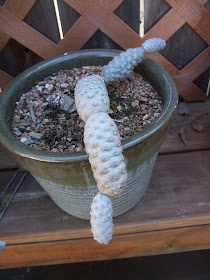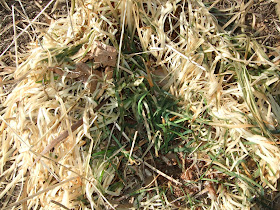Lo! now the direful monster, whose skin clings
To his strong bones, strides o'er the groaning rocks:
He withers all in silence, and his hand
Unclothes the earth, and freezes up frail life.
- William Blake, Poetical Sketches - Winter, 1783

It's taken a couple of bleak winter weeks (and I hope they're the last this year) to prompt me to post after a long hiatus. Texas gardeners are fond of taking risks with marginally hardy plant, and this year has proved which ones have true mettle. The scene last week didn't look promising.
In my garden some things definitely look dead, such as this no-name euphorbia that once upon a time was upright

and the pretty pine-cone cactus that has lost its oomph.

Another of my favorite succulents looks like it has some real green left; it's not an upright form, so its recumbent state is normal.

The society garlic, of which I have many, looked like goners, but then I noticed some bright green at the centers.
I was worried that my manfreda undulata "chocolate chips" that I had dug up and divided when it pupped in the fall would be mush, but it looks like the center spike has life.

I saved what little bulbine survived last year's 17 degrees and replanted it. Through that act of natural selection, it looks like it will pull through.

Aloe "lizard lips," my favorite variegated aloe, earns a gold star for being hardy enough to survive two winters without being brought inside.

In the vegetable garden, the more exotic plants in the mesclun mix are toast

and the more common lettuces like Red Sails and Salad Bowl are a little shriveled but still growing.




